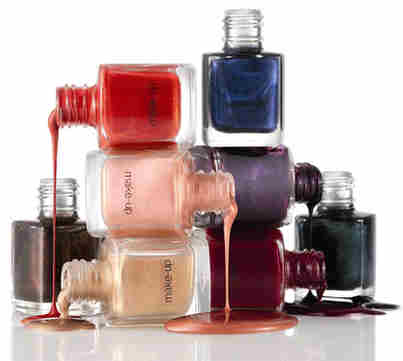一項(xiàng)最新研究發(fā)現(xiàn),指甲油、發(fā)膠以及香水等美護(hù)產(chǎn)品中常見的一種化學(xué)成分可能會(huì)增加女性患糖尿病的風(fēng)險(xiǎn)。這種化學(xué)成分叫做鄰苯二甲酸酯,個(gè)人護(hù)理產(chǎn)品、粘合劑、電子產(chǎn)品,以及汽車、玩具和各類包裝材料中均含有該成分。鄰苯二甲酸酯能夠改變身體某些機(jī)能的正常運(yùn)行規(guī)律,導(dǎo)致內(nèi)分泌失調(diào),從而增加患糖尿病和肥胖癥的風(fēng)險(xiǎn)。研究人員對(duì)2350名女性的尿樣分析后發(fā)現(xiàn),體內(nèi)鄰苯二甲酸單芐酯和鄰苯二甲酸單異丁基酯濃度最高的女性患糖尿病的風(fēng)險(xiǎn)是濃度最低女性的兩倍。不過,研究人員也指出,因?yàn)樵摶瘜W(xué)成分廣泛存在于各類產(chǎn)品中,想要避免接觸到該成分也是件困難的事情;日常生活中,人們可以通過勤除塵、勤洗手來避免該成分進(jìn)入體內(nèi)。

 |
|
Chemicals commonly found in beauty products such as nail polishes, hair sprays and perfumes may increase risk of diabetes for some women, new research suggests. |
Chemicals commonly found in beauty products such as nail polishes, hair sprays and perfumes may increase risk of diabetes for some women, new research suggests.
Researchers analyzed urine samples from 2,350 women who participated in the long-running National Health and Nutrition Examination Survey, a nationally representative sample of American women. They were looking for concentrations of chemicals known as phthalates, which are often found in personal care products and in adhesives, electronics, products used to manufacture cars, toys, packaging and even some coatings for medications.
Phthalates are considered "endocrine-disrupting" because they can alter normal regulation of certain mechanisms in the body, including hormone regulation, and have been tied in previous research to diabetes and obesity risk, Dr. Kenneth Spaeth, director of the Occupational and Environmental Medicine Center's department of population health at North Shore University Hospital in Manhasset, N.Y., told HealthPop. He was not involved in the study.
The researchers found that women with the highest concentrations of two types of phthalates - mono-benzyl phthalate and mono-isobutyl phthalate - were nearly two times more likely to have diabetes compared to women with the least amounts of these chemicals. Women with moderately high levels of the phthalates mono-n-butyl phthalate and di-2-ethylhexyl phthalate were 70 percent more likely to have diabetes compared to their counterparts.
The findings were published in Environmental Health Perspectives, a journal published by the government's National Institute of Environmental Health Sciences.
"This is an important first step in exploring the connection between phthalates and diabetes," said Dr. Tamara James-Todd, a researcher in women's health at Brigham and Women's Hospital in Boston, said in a press release. The researchers could not prove that phthalates caused diabetes or having diabetes increased concentrations of the chemicals in a person's body.
"We know that in addition to being present in personal care products, phthalates also exist in certain types of medical devices and medication that is used to treat diabetes and this could also explain the higher level of phthalates in diabetic women," she added. "So overall, more research is needed."
One of the problems is that chemicals like phthalates are practically unavoidable, according to Spaeth.
"These chemicals are unfortunately ubiquitous," Spaeth explained. "It's pretty clear from studies that we're exposed all day long to these various household or personal care products."
Spaeth says it's a real challenge to reduce phthalate exposure because sometimes the chemical is a metabolic byproduct of another ingredient or a product label may not say it contains phthalates only for phthalates to be found in the packaging the product came in, which does not need to be mentioned on a product label.
"It's really hard to make informed decisions about these kinds of things," he said. "Maybe we'll get to a point when the health effects are more widely recognized, that there will be incentive to change how products are made and packaged."
However Spaeth did say research has shown phthalates can find their way into household dust and people sometimes ingest them that way, so simple steps like frequent vaccuming and dusting, or washing your hands regularly before eating may decrease risk.
相關(guān)閱讀
(Agencies)

(中國(guó)日?qǐng)?bào)網(wǎng)英語點(diǎn)津 Helen 編輯)
